Manage Business Hours
Manage Business Hours
Business Hours define the working hours of an organisation and is typically based on the company's location. However, if your organisation has offices in different countries the business hours followed at the headquarters may not comply with the offices in other time zones. To address this, the CRM lets you create shift hours for different time zones.
For instance, your organisation is located in the US and the business hours is 9 am to 5 pm in the US timezone, now if your company extends its services in other countries like Europe, Japan or India, you can create shift hours for these particular time zones. Similarly, if the employees in your organisation work at different timings (afternoon shift, morning shift), you can create shifts for their work timings. Additionally, you can also create Holiday Lists for different locations and associate it to shifts.
Availability
Users with Administrative profile can access.
Set Business Hours
Use the Business Hours to define the working hours of your organisation. Depending on the working hours of your organisation, you can choose either 24/7 or 24/5 as the business hour. In addition, if your organisation follows different timings on each day or functions on weekends, you can customise the business hours to suit your requirements.
To set business hours,
- Go to Setup > Company Details > Business Hours .
- In the Business Hours page, click Create Business Hour .
- Select a Business Hour from the following list.a) 24 Hours x 7 Days - Select this option if your company operates 24/7. b) 24 Hours x 5 Days - Select this option if your company operates 24/5.
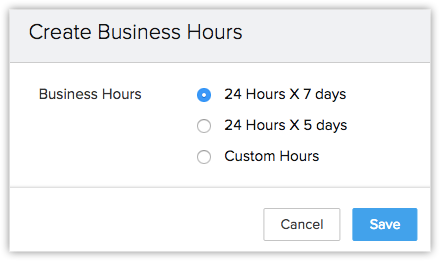 c) Custom Hours - Select this option if you want to customise the business days or hours.
c) Custom Hours - Select this option if you want to customise the business days or hours.- Same hours every day - Select this option if the business hours of the organisation is same everyday and choose the timings from the drop-down list.
- Different hours every day - Select this option if the business hours of the organisation varies each day and choose the timings from the drop-down list.

- Same hours every day - Select this option if the business hours of the organisation is same everyday and choose the timings from the drop-down list.
- Click Save .

- While customising the business hours, you can select the business timing as 24 Hours for both Same Hours Everyday and Different Hours Everyday.
- While setting business hours, you can choose a particular day on which the week in your organisation begins. Based on the day you choose, the data for next week, current week and previous week will be executed for Reports, Smart Filters and Criteria.
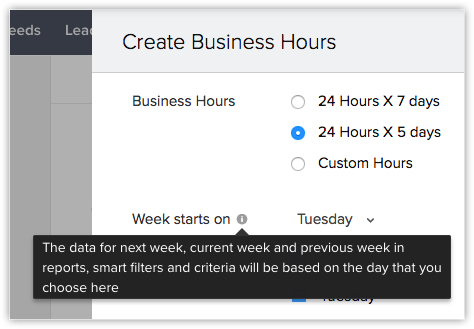
Create and Assign Shifts to Users
You can create shifts for users who work in different time zones or timings. For instance, if a user works for clients based at the US you can create a shift for the US time zone and assign it to the user. Also, depending on the business exigencies you can transfer an user from one shift to another. While transferring, you can choose to transfer the user immediately or at a later date. If a transfer is scheduled for a later date, you are allowed to select any date up till 6 months.
A) To create shifts
- Go to Setup> Company Details > Business Hours .
- Click Create Shift Hours .
- In the Create Shift Hours page, enter the Shift name .
- Select the timezone from the drop-down list.
- In Shift hours,a) Same Hours Everyday - Select this option if the shift hour is same everyday and choose the timings from the drop-down list.b) Different Hours Everyday - Select this option if the shift hour varies each day and choose the timings from the drop-down list.
- Click Save .
B) To assign shift
- Edit the shift that your created.
- Select the users from the AssignTo drop-down list.
- Click Done and then Save .

- You can create up to 30 shifts in your organisation.
- If you edit the organisation's business hour such that the shift's timing does not fall within the business hour, you will be alerted to edit the shift hours accordingly.
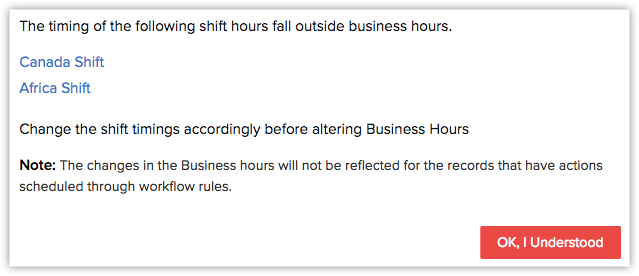
Add Break Hours
You can include the break hours for every shift, that will help know the users unavailability during a particular shift. It will help you plan the events according to a users availability. Also, if an event is created during the break hours an alert will be thrown notifying about the users unavailability.
Similar to shift hours, you can choose the same or different break hours for each day in a week. Below are few important points you need to consider before defining the break hours:
- One shift can have a maximum of two break hours.
- Break hours must comply with the shift hours.
To add break hours
- After defining the shift hours, go to Break Hours .
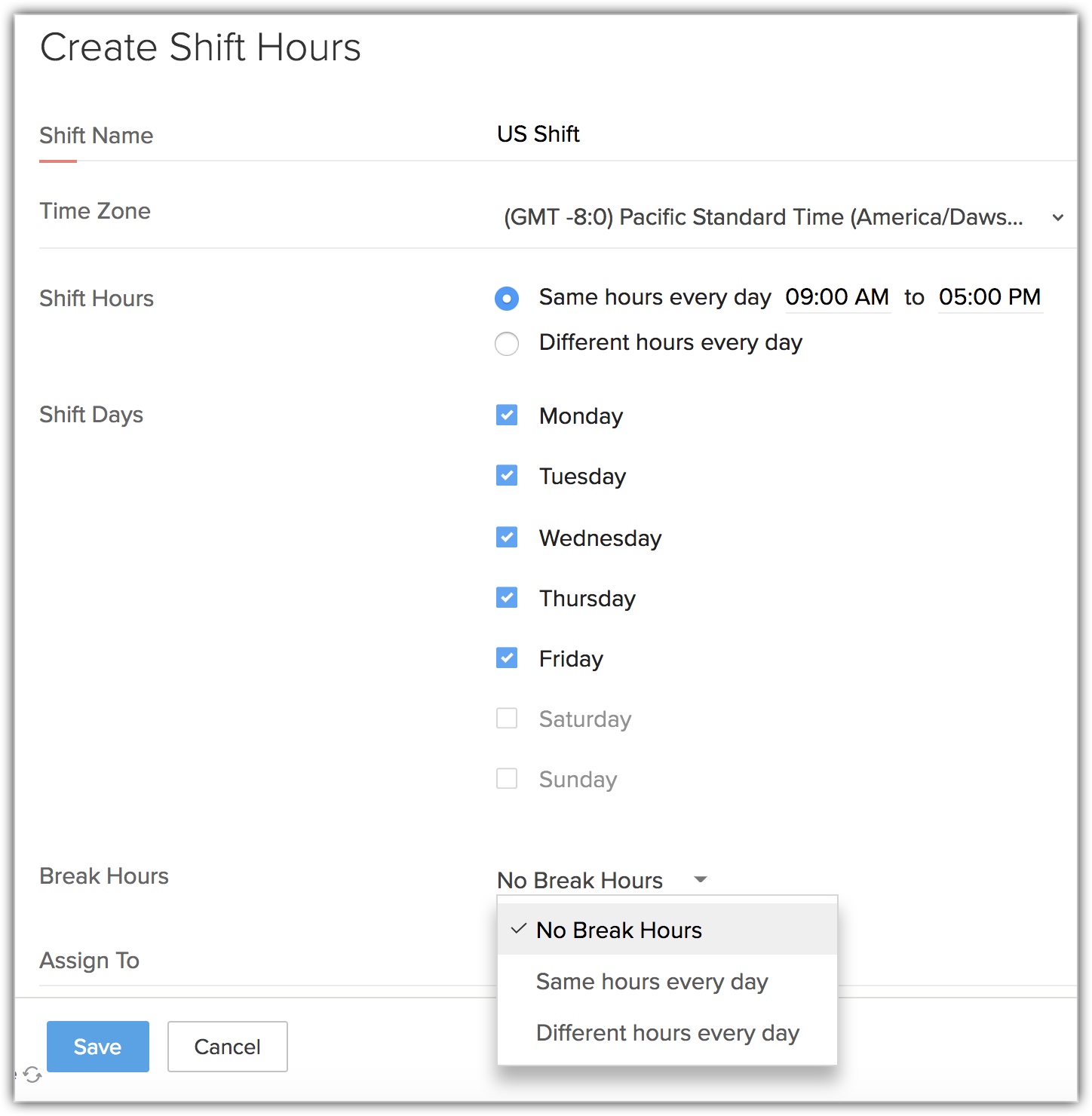
- Select Same hours every day or Different hours every day from the drop-down list.
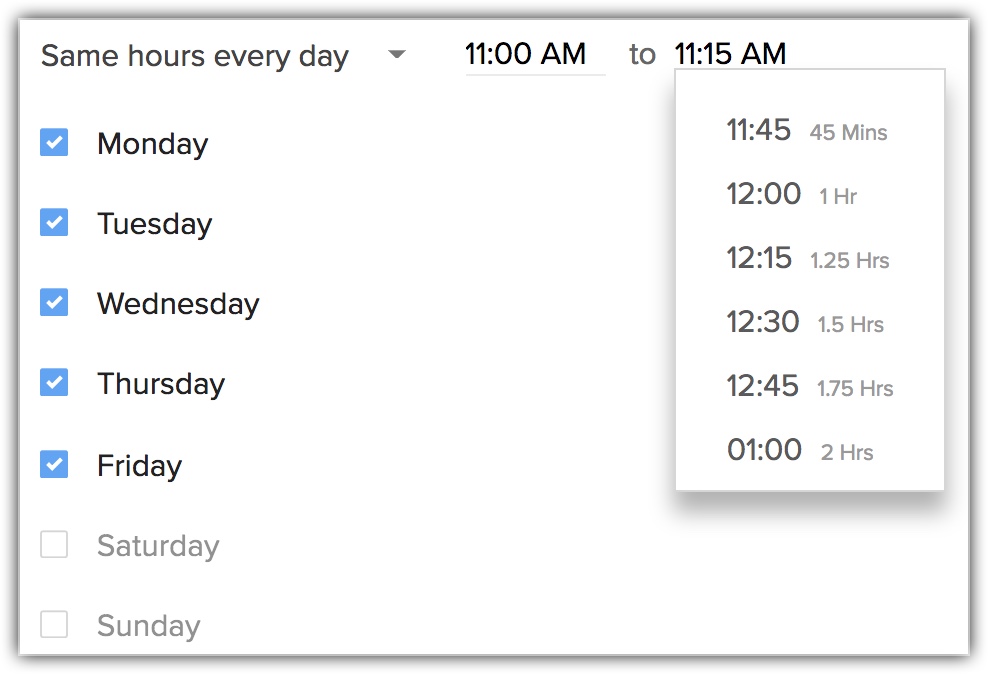
- Select the time from the drop-down list.
- Click Done and Save .
Create Holiday Lists
In CRM you can create a holiday list depending on different locations. Each shift can be associated to a single holiday list per year at a given point of time. You can create a holiday list for the current as well as the forthcoming year.
A) To create a holiday list
- Go to Setup > Company Details > Holidays .
- In Holidays Details page, click Create Holiday List .
- In Apply To Shift , select the shift(s) from the drop-down list.(Note that this option will appear only if you have already created shifts)
- Choose the Year from the drop-down list.
- Enter Holiday Name and select the Date from the calendar.(Click the plus icon to add more holidays)
- Click Save .
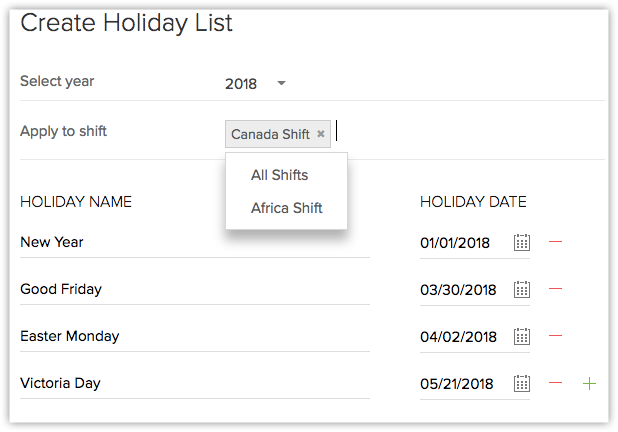


- If you create a holiday list before creating shifts, the holiday list will by default be applicable to all the shifts that are created later.
B) To edit a holiday list
- In the Holiday Details page, select the Holiday List.
- Click Edit List .
- Add/delete holidays or edit details in the existing holidays.
- Click Save .
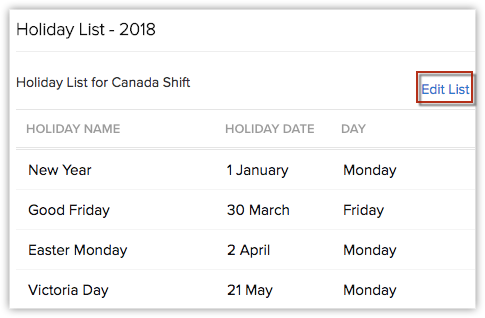
Mark As Unavailable in the Calendar
You can mark yourself unavailable for a particular time of the day in the CRM calendar, this will ensure that the user is alerted about your unavailability if an event is created for that time.
To mark yourself unavailable
- Click the Calendar icon in the top panel.
- Choose a Date > Create .Alternately, you can right click on the specific date.
- Select Mark As Unavailable .
- In the pop-up, select the Date and Time .
- Enter Comments , if required.
- Click Save .



- If private events are imported from other sources (google calendar sync), those will be created as "unavailable" events in the CRM calendar.
How Business Hour Influences Other CRM Functions
Assigning Events
You can assign an event to the user based on their availability. If an event is assigned on a day which is either marked unavailable or not a working day of the user, you will be alerted to reschedule the event to another day. You can either reschedule the event or assign it anyway irrespective of the user's availability.
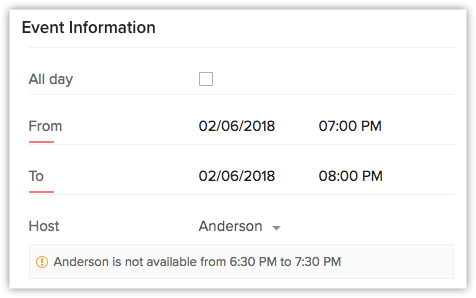
Setting Due Date in Repeat Events
If an event in your organisation repeats at regular intervals, you can skip the weekends/holidays/non-working days. For events that repeat daily you can skip the weekends and holidays. If the event repeats monthly or yearly you can avoid it from repeating on a non-working day of the user.
To repeat event,
- Select the Repeat Type from the drop-down list and do the following:a) Daily - Click Except weekends and holidays .b) Custom - Select Monthly / Yearly from the drop-down list.c) Click the checkbox Reschedule events to the next working day if the selected day is not a working day .
- Click Done .

Setting Due Date in Repeat Tasks
If a task gets repeated everyday you can skip the weekends and holidays, similarly if a task is repeated yearly or monthly you can skip the non-business day of the user.
To repeat task,
- Select the Repeat Type from the drop-down list and do the following:a) Daily - Click Except weekends and holidays .b) Custom - Select Monthly / Yearly from the drop-down list.c) Click Set due date to the next business day if the selected day is not a working day .
- Click Done .
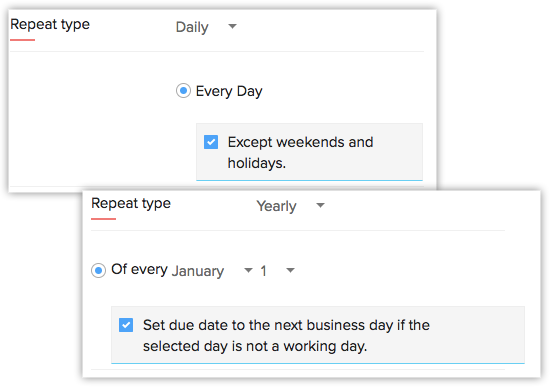
Workflow Rules
Date/DateTime Based Trigger
You can set the workflow rule to trigger either after or before "n" business days/hours to skip non-working day of the user.
To select the date/time,
- In Workflow Rules , select Rule Criteria > When do you want to execute this rule?
- Select On a Date/DateTime .
- In Execute, enter the Number of days/hours .
- Select Business hour(s) / Business day(s) from the drop-down list.
- Click Next .
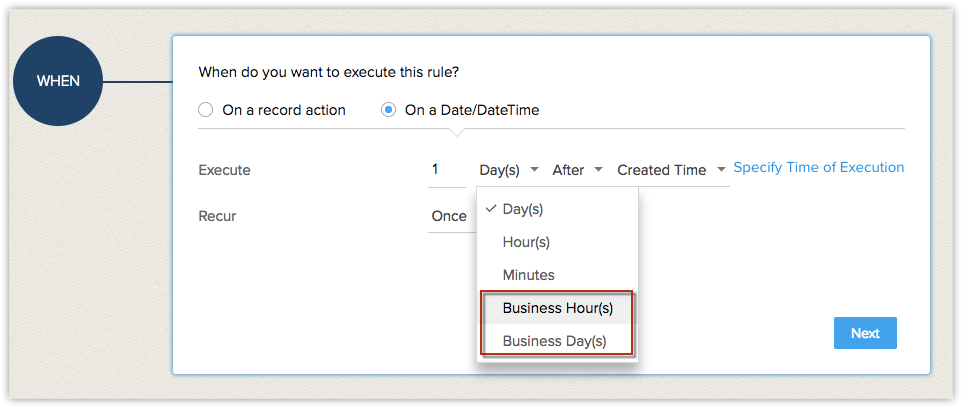
Instant Actions
While creating tasks as an instant action you can choose the due date to skip the non-working days.
To skip non-business days,
- In the Instant Action , select Task .
- In the Assign Task pop up, select Business days from the drop-down list.

Schedule Actions
Schedule actions can be set to trigger after "n" business days / hours to skip the non-working day of the user.
To skip non-business days,
- Click Scheduled Actions .
- In Execute , enter the number of days.
- Select Business hour(s) / Business day(s) from the drop-down list.
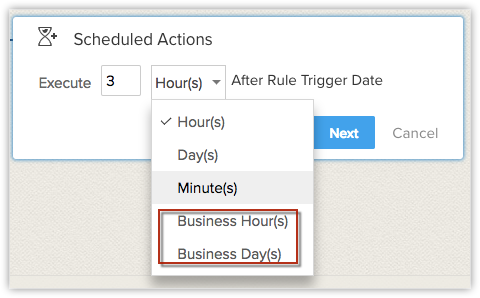
Tasks in Blueprint Transition
While defining a task in blueprint transitions you can skip the non-business day of the user, to ensure that the due date is scheduled when the user is available.
To set task due date,
- In the Blueprint Transitions > click After .
- Select Task , in Due date enter the number of days.
- Select Business days from the drop-down list.
- Click Save .
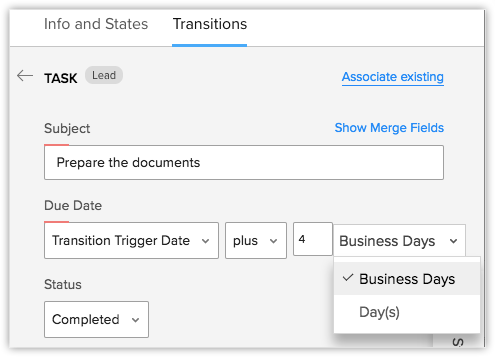
Related Articles
Automate your Business Process
Automate your Business Process The CRM offers various tools to automate repetitive actions in your business process and help you complete tasks quickly and effectively: Assignment rule, Workflows, Blueprint, Approval Process, Schedules, Actions, Case ...Manage Hierarchy Preference
Manage Hierarchy Preference A hierarchy structure in an organisation is defined to rank members according to their designations. The CRM provides two different hierarchy structures for your organisation: Role Hierarchy and Reporting Hierarchy. You ...Manage your Data
Manage your Data There are a bunch of common operations that you would be performing as an administrator. Out of which, a few important tasks are to maintain a clean database and discover strategies to assess and improve the quality of your data in ...Create and Manage Groups
Create and Manage Groups Create Groups Assign Users to Group Edit Groups Delete Groups Share Records with Groups Create Groups You can create different types of user groups and share the common records among groups. To create groups Go ...Manage Company Details
Manage Company Details Edit Company Details Set Currency Personalize Logo Set Organization Time Zone Assign Super Administrator There are certain organisation specific details, which help differentiate one organisation from another. The CRM ...